User:Godot13/sandbox/List of U.S. Fractional Currency
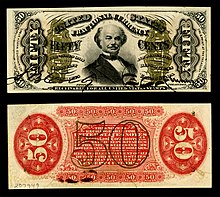
Fractional Currency, also referred to as “paper coins,”[1] and Shinplasters, was introduced by the United States Federal Government following the outbreak of the Civil War. These notes were in use between 21 August 1862 and 15 February 1876, issued in 3, 5, 10, 15, 25, and 50 cent denominations across five issuing periods.[2] The complete type set below is part of the National Numismatic Collection, housed at the National Museum of American History, part of the Smithsonian Institution.

The Civil War economy caused a shortage of United States coinage[3] - gold and silver coins were hoarded given their intrinsic bullion value.[4][5] In late December 1861, the United States Department of the Treasury suspended specie payments[6] and banks in New York City stopped redeeming paper money for gold and silver resulting in the near total disappearance of coins from the marketplace.[7] This created significant disruption across businesses and trade[8] and fueled currency speculation (e.g., redeeming banknotes for silver coin which was then sold at a premium as bullion).[9] Alternate methods of providing small change included the reintroduction of Spanish quarter dollars in Philadelphia,[8] cutting dollar bills in quarters or halves[10], refusing to provide change (without charging a premium for providing silver coins),[10] or the issuance of shinplasters, forbidden by law in many states.[10]
Beginning in 1862, postage stamps were informally used by some in east coast cities to fill the void left by the absence of coinage[4], and the sale of postage stamps (e.g., in New York) rose almost tenfold.[5] Civil War-era stamps had a very short life due to rapid deterioration.[7] One attempt to increase the durability of stamps as an emergency medium of exchange was pioneered by businessman John Gault who proposed encasing the postage stamps in round brass cases with advertising on the reverse. The circulation was too small to effect any real change.[2]
Postage currency
[edit]Secretary of the Treasury Francis E. Spinner has been credited with finding the solution to the shortage of coinage, and in doing so created Postage currency (which led into the use ofFractional currency. Postage (or postal) currency was the first of five issues of US Post Office fractional paper money printed in 5¢, 10¢, 25¢, and 50¢ denominations and issued from August 21, 1862 through May 27, 1863.
Spinner proposed using postage stamps, affixed to Treasury paper, [11] with his signature on the bottom (see illustration below). Based on this initiative, Congress supported a temporary solution involving fractional currency and on 17 July 1862, President Lincoln signed the Postage Currency Bill into law.[7] The intent however was not that stamps should be a circulating currency.[12]
The design of the First Issue (Postage Currency) was directly based on Spinner’s original handmade examples. Some varieties even had perforated stamp-like edge. While not actually legal tender, postage currency could be exchanged for United States Notes in $5 lots and were receivable in payment of all dues to the United States, up to $5. Subsequent issues would no longer include images of stamps and were referred to as Fractional Currency.
In an October 1862 letter to the editor of the New York Times, a writer states that “Postage stamps are issued by the Post-office Department only, and by law they can be used only for the prepayment of postage…Postage currency is issued only by the Secretary of the Treasury or his Assistants pursuant to the Act of Congress approved July 17, 1862”.[13] Despite the July 1862 legislation, postage stamps remained a form of currency until Postage Currency gained momentum in the spring of 1863.[14]
Fractional currency
[edit]In 1863, Secretary Chase asked for a new Fractional Currency that was harder to counterfeit than the Postage Currency. The new Fractional Currency notes were different from the 1862 Postage Currency issues. They were more colorful with printing on the reverse. Fractional currency shields which had single sided specimens were sold to banks top provide a standard for comparison for detecting counterfeits.[15] Postage and fractional currency remained in use until 1876 when Congress authorized the minting of fractional silver coins to redeem the outstanding fractional currency. Today, the original postage currency of 1862 is often collected alongside postage stamps of that era.
Issuing periods
[edit]| Issuing period | Start date | End date | Denominations issued | Payment obligation | Comments |
|---|---|---|---|---|---|
| First Issue | 21 Aug 1862 | 27 May 1863 | $0.05, $0.10, $0.25, $0.50 | "Exchangeable for United States Notes by any Assistant Treasurer or designated U.S. Depositary in sums not less than five dollars. Receivable in payments of all dues to the U. States less than five dollars."[16] | Issued as Postage Currency, these notes have two main varieties: 1) straight versus perforated edges, and 2) the presence or absence of the American Bank Note Co. monogram (ABC) on the reverse (e.g., see Fr.1240 and Fr. 1312).[nb 1] All four denominations bear the stamp motif on the obverse. |
| Second Issue | 10 Oct 1863 | 23 Feb 1867 | $0.05, $0.10, $0.25, $0.50 | "Exchangeable for United States Notes by the Assistant Treasurer and designated depositories of the U.S. in sums not less than three dollars. Receivable in payment of all dues to the United States less than five dollars except customs."[16] | All second and some third issue note varieties have surcharge letters and numbers printed in the corners of the reverse. |
| Third Issue | 5 Dec 1864 | 16 Aug 1869 | $0.03, $0.05, $0.10, $0.25, $0.50 | Same as Second Issue | First appearance of signatures on Fractional Currency |
| Fourth Issue | 14 Jul 1869 | 16 Feb 1875 | $0.10, $0.15, $0.25, $0.50 | Same as Second Issue | |
| Fifth Issue | 26 Feb 1874 | 15 Feb 1876 | $0.10, $0.25, $0.50 | Same as Second Issue |
“…no portrait or likeness of any living person…”
[edit]Three people were depicted on fractional currency during their lifetime: Francis E. Spinner (Treasurer of the United States), William P. Fessenden (U.S. Senator and Secretary of the Treasury), and Spencer M. Clark (Superintendent of the National Currency Bureau).[17] Both Spinner and Clark each decided to have their portrait depicted on currency, which created controversy.[18] Republican Representative Martin R. Thayer of Pennsylvania was an outspoken critic, suggesting that the Treasury’s privilege of portrait selection for currency[19] was being abused.[nb 2] On 7 April 1866, led by Thayer,[21] Congress enacted legislation specifically stating “that no portrait or likeness of any living person hereafter engraved, shall be placed upon any of the bonds, securities, notes, fractional or postal currency of the United States.”[22]
Varieties
[edit]The table is sorted in chronological issue order (series) by denomination (value). The varieties column briefly describes the subtle differences between varieties of notes that are categorized as the same general type. The brief table key defines and elaborates on frequently used terms in the varieties column.
| Term | Description |
|---|---|
| (AS) | Autographed signatures |
| Blue end paper | Generally visible on both sides (sometimes more on the reverse), the paper has a blue tint covering roughly one-third of the note’s surface from the vertical edge toward the center. |
| Design figure | Either a “1” or “a”, or both, located on the obverse (front) of the note; also known as position indicators (third issue notes only). |
| Fiber paper | |
| Monogram | ABCo for American Banknote Company (rev. first issue notes only). |
| Obv. | Obverse side (front) of the note. |
| Overprint | |
| Perforated (edges) | Describing first issue notes only. |
| (PS) | Printed signatures. |
| Rev. | Reverse side (back) of the note. |
| Silk fibers | Embedded in the currency paper as an anti-counterfeiting measure. |
| Straight (edges) | Describing first issue notes only. |
| Surcharge | Bronze ink overprint letters and numbers in the corners on the reverse (second and third issues) |
| Watermarked | “USUSUS” |
Complete Type Set of United States Fractional Currency
[edit]| Value | Series | Fr. No.[nb 3] | Image | Portrait | Varieties |
|---|---|---|---|---|---|
| $0.05 | First Issue | Fr.1231 | 
|
Thomas Jefferson | 1228 – Perforated; monogram. 1229 – Perforated; no monogram. 1230 – Straight; monogram. 1231 – Straight; no monogram. |
| $0.10 | First Issue | Fr.1240 | 
|
George Washington | 1240 – Perforated; monogram. 1241 – Perforated; no monogram. 1242 – Straight; monogram. 1243 – Straight; no monogram. |
| $0.25 | First Issue | Fr.1280 | 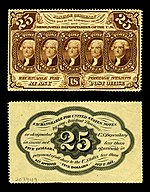
|
Thomas Jefferson | 1279 – Perforated; monogram. 1280 – Perforated; no monogram. 1281 – Straight; monogram. 1282 – Straight; no monogram. |
| $0.50 | First Issue | Fr.1312 | 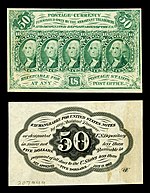
|
George Washington | 1310 – Perforated; monogram. 1311 – Perforated; no monogram. 1311a – Same, except 14 versus 12 perf/20 mm. 1312 – Straight; monogram. 1314 – Straight; no monogram. |
| $0.05 | Second Issue | Fr.1232 | 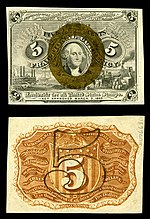
|
George Washington | 1232 – No surcharge. 1233 – Surcharge “18-63”. 1234 – Surcharge “18-63” and “S”. 1235 – Surcharge “18-63” and “R-1”; Fiber paper. |
| $0.10 | Second Issue | Fr.1246 | 
|
George Washington | 1244 – No surcharge. 1245 – Surcharge “18-63”. 1246 – Surcharge “18-63” and “S”. 1247 – Surcharge “18-63” and “I”. 1248 – Surcharge “0-63”. 1249 – Surcharge “18-63” and “T-1”. |
| $0.25 | Second Issue | Fr.1284 | 
|
George Washington | 1283 – No surcharge. 1284 – Surcharge “18-63”. 1285 – Surcharge “18-63” and “A”. 1286 – Surcharge “18-63” and “S”. 1287 – Unissued Friedberg number. 1288 – Surcharge “18-63” and “2”. 1289 – Surcharge “18-63” and “T-1”; fiber paper. 1290 – Surcharge “18-63” and “T-2”; fiber paper. |
| $0.50 | Second Issue | Fr.1322 | 
|
George Washington | 1314 – No surcharge. 1315 – Unissued Friedberg number. 1316 – Surcharge “18-63”. 1317 – Surcharge “18-63” and “A”. 1318 – Surcharge “18-63” and “1”. 1319 – Unissued Friedberg number. 1320 – Surcharge “18-63” and “0-1”; fiber paper. 1321 – Surcharge “18-63” and “R-2”; fiber paper. 1322 – Surcharge “18-63” and “T-1”; fiber paper. |
| $0.03 | Third Issue | Fr.1226 | 
|
George Washington | 1226 – Portrait light background. 1227 – Portrait dark background. |
| $0.05 | Third Issue | Fr.1238 | 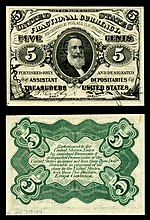
|
Spencer Clark | 1236 – Red reverse. 1237 – Red reverse; design letter “a”. 1238 – Green reverse. 1239 – Green reverse; design letter “a”. |
| $0.10 | Third Issue | Fr.1254 | 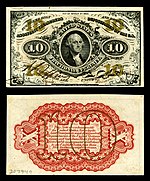
|
George Washington | 1251 – 1254 Red reverse.[nb 4] 1255 – 1256 Green reverse.[nb 5] |
| $0.25 | Third Issue | Fr.1294 | 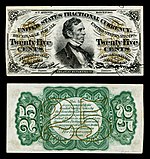
|
William Fessenden | 1291 – 1293 Red reverse[nb 6] 1294 – 1300 Green reverse[nb 7] |
| $0.50 | Third Issue | Fr.1328 | 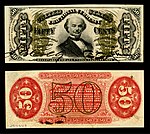
|
Francis Spinner | 1324 – 1330 Red reverse; surcharge “A-2-6-5”.[nb 8] 1331 – 1334 Green reverse; no surcharge.[nb 9] |
| $0.50 | Third Issue | Fr.1339 | 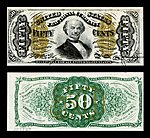
|
Francis Spinner | 1339 – Green reverse; no surcharge or design figures. 1340 – Green reverse; design figures “1” and “a”. 1341 – Green reverse; design figure “1”. 1342 – Green reverse; design figure “a”. |
| $0.50 | Third Issue | Fr.1355 | 
|
Justice holding scales | 1343 – 1346 Red reverse; no surcharge.[nb 11] 1347 – 1350 Red reverse; surcharge “A-2-6-5”.[nb 12] 1351 – 1354 Red reverse; surcharge “S-2-6-4”; (PS).[nb 13] 1355 – 1357 Red reverse; (AS) Colby and Spinner.[nb 14] 1358 – 1361 Green reverse; no surcharge.[nb 15] 1362 – 1365 Green reverse; surcharge “A-2-6-5” (narrow).[nb 16] 1366 – 1369 Green reverse; surcharge “A-2-6-5” (wide).[nb 17] 1370 – 1373a Green reverse; surcharge “A-2-6-5”; fiber paper.[nb 18] |
| $0.10 | Fourth Issue | Fr.1259 | 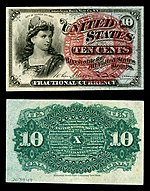
|
Bust of Liberty | 1257 – Large red seal; watermarked; silk fibers (pink). 1258 – Large red seal; silk fibers (pink). 1259 – Large red seal; silk fibers (violet); blue end paper. 1260 – Does not exist. 1261 – Smaller red seal; silk fibers (violet); blue end paper. |
| $0.15 | Fourth Issue | Fr.1269 | 
|
Bust of Columbia | 1267 – Large red seal; watermarked; silk fibers (pink). 1268 – Large red seal; silk fibers (pink). 1269 – Large red seal; silk fibers (violet); blue end paper. 1270 – Does not exist. 1271 – Smaller red seal; silk fibers (violet); blue end paper. |
| $0.25 | Fourth Issue | Fr.1303 | 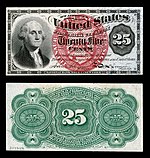
|
George Washington | 1301 – Large red seal; watermarked; silk fibers (pink). 1302 – Large red seal; silk fibers (pink). 1303 – Large red seal; silk fibers (violet); blue end paper. 1307 – Smaller red seal; silk fibers (violet); blue end paper.[nb 19] |
| $0.50 | Fourth Issue | Fr.1374 | 
|
Abraham Lincoln | 1374 – Large seal; watermarked; silk fibers (pink). 1375 – Delisted Friedberg number. |
| $0.50 | Fourth Issue | Fr.1376 | 
|
Edwin Stanton | 1376 – Small red seal; silk fibers (violet); blue end paper. |
| $0.50 | Fourth Issue | Fr.1379 | 
|
Samuel Dexter | 1379 - Green seal; silk fibers (light violet); blue end paper. |
| $0.10 | Fifth Issue | Fr.1265 | 
|
William Meredith | 1264 – Green seal. 1265 – Red seal; long, thin key (in Treasury seal). 1266 – Red seal; short, thick key (in Treasury seal). |
| $0.25 | Fifth Issue | Fr.1308 | 
|
Robert Walker | 1308 – Long, thin key (in Treasury seal). 1309 – Short, thick key (in Treasury seal). |
| $0.50 | Fifth Issue | Fr.1381 | 
|
William Crawford | 1380 – Red seal; light pink paper on obvserse; silk fibers. 1381 – Red seal; blue end paper; silk fibers. |
Notes
[edit]- ^ The reverse of the first issue was originally printed by the National Bank Note Company. As a security precaution, the Treasury moved the printing contract to the American Bank Note Company who added their monogram ABC to the reverse of the remaining first issue notes.[16]
- ^ “But now we see upon our current paper money not only the heads of the illustrious men of our country long since gathered to their fathers, but of living secretaries of the Treasury, and even of such subordinate officers as the superintendent of the Currency Printing Bureau, Mr. S.M. Clark.”[20]
- ^ "Fr" numbers refer to the numbering system in the widely-used Friedberg reference book. Fr. numbers indicate varieties existing within a larger type design.[23]
- ^ 1251 – Red reverse.
1252 – Red reverse; design numeral “1”.
1253 – Red reverse; (AS) Colby and Spinner.
1254 – Red reverse; (AS) Jeffries and Spinner. - ^ 1255 – Green reverse.
1255a – Green reverse; (AS) Colby and Spinner.
1256 – Green reverse; design numeral “1”. - ^ 1291 – Red reverse.
1292 – Red reverse; design letter “a”.
1293 – Friedberg number removed from use. - ^ 1294 – Green reverse.
1295 – Green reverse; design letter “a”.
1296 – Green reverse; large design letter “a”.
1297 – Green reverse; surcharge “M-2-6-5”; fiber paper.
1298 – Green reverse; same as 1297; design letter “a”.
1299 – Green reverse; surcharge “M-2-6-5”; obverse ornamental designs in sold bronze overprint; fiber paper.
1300 – Green reverse; same as 1299; design letter “a”. - ^ 1324 – Red reverse; surcharge “A-2-6-5”; no design figures.
1325 – Red reverse; surcharge “A-2-6-5”; design figures “1” and “a”.
1326 – Red reverse; surcharge “A-2-6-5”; design figure “1”.
1327 – Red reverse; surcharge “A-2-6-5”; design figure “a”.
1328 – Red reverse; surcharge “A-2-6-5”; (AS) Colby and Spinner.
1329 – Red reverse; surcharge “A-2-6-5”; (AS) Allison and Spinner.
1330 – Red reverse; surcharge “A-2-6-5”; (AS) Allison and New. - ^ 1331 – Green reverse; no surcharge; no design figures.
1332 – Green reverse; no surcharge; design figures “1” and “a”.
1333 – Green reverse; no surcharge; design figure “1”.
1334 – Green reverse; no surcharge; design figure “a”. - ^ 1335 – Green reverse; surcharge “A-2-6-5”; no design figures.
1336 – Green reverse; surcharge “A-2-6-5”; design figures “1” and “a”.
1337 – Green reverse; surcharge “A-2-6-5”; design figure “1”.
1338 – Green reverse; surcharge “A-2-6-5”; design figure “a”. - ^ 1343 – Red reverse; no surcharge; no design figures.
1344 – Red reverse; no surcharge; design figures “1” and “a”.
1345 – Red reverse; no surcharge; design figure “1”.
1346 – Red reverse; no surcharge; design figure “a”. - ^ 1347 – Red reverse; surcharge “A-2-6-5”; no design figures.
1348 – Red reverse; surcharge “A-2-6-5”; design figures “1” and “a”.
1349 – Red reverse; surcharge “A-2-6-5”; design figure “1”.
1350 – Red reverse; surcharge “A-2-6-5”; design figure “a”. - ^ 1351 – Red reverse; surcharge “S-2-6-4”; (PS); no design figures; fiber paper.
1352 – Red reverse; surcharge “S-2-6-4”; (PS); design figures “1” and “a”; fiber paper. In 2004, a Fr. 1352 (one of only three known), sold at public auction for $126,500.[24]
1353 – Red reverse; surcharge “S-2-6-4”; (PS); design figure “1”; fiber paper.
1354 – Red reverse; surcharge “S-2-6-4”; (PS); design figure “a”; fiber paper. - ^ 1355 – Red reverse; (AS) Colby and Spinner; no surcharge or design figures.
1356 – Red reverse; (AS) Colby and Spinner; surcharge “A-2-6-5”.
1357 – Red reverse; (AS) Colby and Spinner; surcharge “A-2-6-4”; fiber paper. - ^ 1358 – Green reverse; no surcharge; no design figures.
1359 – Green reverse; no surcharge; design figures “1” and “a”.
1360 – Green reverse; no surcharge; design figure “1”.
1361 – Green reverse; no surcharge; design figure “a”. - ^ 1362 – Green reverse; surcharge “A-2-6-5” (narrow); no design figures.
1363 – Green reverse; surcharge “A-2-6-5” (narrow); design figures “1” and “a”.
1364 – Green reverse; surcharge “A-2-6-5” (narrow); design figure “1”.
1365 – Green reverse; surcharge “A-2-6-5” (narrow); design figure “a”.
*narrow – spacing of the surcharge. - ^ 1366 – Green reverse; surcharge “A-2-6-5” (wide); no design figures.
1367 – Green reverse; surcharge “A-2-6-5” (wide); design figures “1” and “a”.
1368 – Green reverse; surcharge “A-2-6-5” (wide); design figure “1”.
1369 – Green reverse; surcharge “A-2-6-5” (wide); design figure “a”.
*wide – spacing of the surcharge. - ^ 1370 – Green reverse; surcharge “A-2-6-5”; fiber paper; no design figures.
1371 – Green reverse; surcharge “A-2-6-5”; fiber paper; design figures “1” and “a”.
1372 – Green reverse; surcharge “A-2-6-5”; fiber paper; design figure “1”.
1373 – Green reverse; surcharge “A-2-6-5”; fiber paper; design figure “a”.
1373a – Green reverse; surcharge “A-2-6-4”; fiber paper; (PS); no design figure. - ^ Fr.1304, 1305, and 1306 are unassigned.[25]
References
[edit]- ^ Pastimes: Numismatics, The New York Times, retrieved 2013-05-03
{{citation}}: Italic or bold markup not allowed in:|publisher=(help) - ^ a b Friedberg
- ^ Pastimes: Numismatics, The New York Times, retrieved 2013-05-03
{{citation}}: Italic or bold markup not allowed in:|publisher=(help) - ^ a b Anderson, p. 303.
- ^ a b Reed, p. 298.
- ^ Mitchell, p. 537
- ^ a b c Kravitz
- ^ a b Mitchell, p. 553
- ^ Mitchell, p. 540
- ^ a b c Mitchell, p. 554
- ^ Spaulding, Elbridge Gerry (1869). History of the Legal Tender Paper Money issued during the Great Rebellion. Buffalo NY: Express Printing Co. pp. 165–166.
- ^ History Timeline, Bureau of Engraving and Printing, retrieved 2013-05-03
- ^ The Postage Stamp Currency; Statement of City Postmaster Wakeman in Reference to Defaced Postage Stamps, The New York Times, retrieved 2013-05-03
{{citation}}: Italic or bold markup not allowed in:|publisher=(help) - ^ Reed, p. 302.
- ^ Friedberg, Arthur L.; Friedberg, Ira S. (2010-07-30). Paper Money of the United States: A Complete Illustrated Guide With Valuations. Coin & Currency Institute. p. 182. ISBN 9780871845191. Retrieved 17 July 2013.
- ^ a b c Friedberg, p. 174.
- ^ "BEP Directors – Spencer M. Clark". Bureau of Engraving and Printing. Retrieved 9 September 2013.
- ^ Cuhaj, p. 407.
- ^ Portraits & Designs, U.S. Treasury Website, retrieved 9 September 2013
- ^ "Congress". The Nation. 2. New York: Joseph H. Richards: 387. 29 March 1866. Retrieved 9 September 2013.
- ^ Rothbard, p. 126.
- ^ http://www.monetarylaws.com/ml2j.htm. Retrieved 9 September 2013.
{{cite web}}: Missing or empty|title=(help) - ^ Friedberg, Arthur L. & Ira S.
- ^ Heritage Currency Auctions – Central States 2005. Ivy Press. 2005. p. 65. ISBN 1932899642. Retrieved 9 September 2013.
{{cite book}}: Cite has empty unknown parameter:|book=(help) - ^ Friedberg, Arthur L. & Ira S.
Books & Journals
[edit]- Anderson, George L. (1939). "The proposed resumption of silver payments in 1873". Pacific Historical Review. 8 (3). University of California Press: 301–316. Retrieved 19 July 2013.
- Cuhaj, George S. (2012). Standard Catalog of United States Paper Money (31 ed.). Iola, WI: Krause Publications. p. 407. ISBN 978-1-4402-3087-5. Retrieved 9 September 2013.
{{cite book}}: Cite has empty unknown parameter:|book=(help) - Friedberg, Arthur L.; Friedberg, Ira S. (2010). Paper money of the United States (19th ed.). Coin & Currency Institute. ISBN 0-87184-519-9.
- Kravitz, Robert J. (2012). A collector’s guide to postage & fractional currency: The pocket change of the Union (2nd ed.). Coin & Currency Institute. p. 199. ISBN 978-087184-204-6.
{{cite book}}: Cite has empty unknown parameter:|book=(help) - Mitchell, Wesley C. (1902). "The circulating medium during the Civil War". Journal of Political Economy. 10 (4). The University of Chicago Press: 537–574. Retrieved 19 July 2013.
- Reed, Fred (2012). "One hundred and fifty summers ago Civil War postage stamp envelopes circulated as small change". Paper Money. 280 (July/August). Society of Paper Money Collectors: 298–304.
- Rothbard, Murray N. (2002). A History of Money and Banking in the United States – The Colonial Era to World War II. Auburn, AL: Ludwig von Mises Institute. ISBN 0-945466-33-1. Retrieved 9 September 2013.
{{cite book}}: Cite has empty unknown parameter:|book=(help) - Spaulding, Elbridge G. (1869). History of the Legal Tender Paper Money issued during the Great Rebellion (2nd ed.). Buffalo, NY: Express Printing Co. pp. 165–66. ISBN 978-087184-204-6. Retrieved 9 September 2013.
Additional reading
[edit]- Blake, George Herbert (1908). United States paper money. George H. Blake.
{{cite book}}: Cite has empty unknown parameter:|book=(help) - Knox, John Jay (1888). United States Notes: A history of the various issues of paper money by the government of the United States (3rd ed.). Charles Scribner’s Sons.
{{cite book}}: Cite has empty unknown parameter:|book=(help) - Lera, Thomas (2011). "In the National Postal Museum: Postage and Fractional Currency". Collectors Club Philatelist. 90 (4): 235–237.
{{cite journal}}:|access-date=requires|url=(help)



